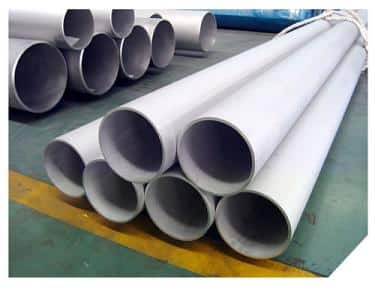Here to learn
Performance and characteristics of 321 stainless steel pipe

TP 321 is a stable stainless steel. Its main advantage is that it has excellent resistance to intergranular corrosion after being exposed to the chromium carbide precipitation temperature range of 800 ° F to 1500 ° F (427 ° C to 816 ° C). Alloy 321 stainless steel pipe can stably form chromium carbide by adding titanium.
321 321H stainless steel is a titanium stabilized version of 304, which is used for specific applications within the sensitization temperature range. Its anti-sensitization ability and its high strength at high temperature make it suitable for applications where 304 will be sensitized or 304L thermal strength is insufficient. When exposed to a slightly corrosive environment, there will be no intergranular corrosion of weld corrosion. However, welding 321 must not be used in a highly oxidizing environment because it is vulnerable to "knife line" erosion. However, 321 is a better choice in the working temperature environment of more than 500 ° C, so it has its own advantages. Alloy 321 stainless steel pipe is also conducive to high-temperature use due to its good mechanical properties. Alloy 321 stainless steel has higher creep and stress fracture properties than alloy 304, especially alloy 304L can also be considered for sensitive and intergranular corrosion problems.
321 321H stainless steel is basically made of 304 stainless steel. The difference between them is that very little titanium is added. The real difference is their carbon content. The higher the carbon content, the greater the yield strength. 321 stainless steel has advantages in high temperature environment due to its excellent mechanical properties. Compared with 304 alloy, 321 stainless steel has better ductility and stress fracture resistance. In addition, 304L can also be used to resist sensitization and intergranular corrosion.
Grade 304L Stainless Steel Pipe is easier to obtain in most product forms, so if only resistance to intergranular corrosion after welding is required, 321 is usually preferred. However, the thermal strength of 304L is lower than that of 321, so it is not the best choice if it is required to withstand the operating environment above 500 ° C.
Stainless steel: SUS321 ● Characteristics and scope of application: Ti is added to improve intergranular corrosion resistance, and it is not recommended to be used as decorative parts. ● Chemical composition: carbon C: ≤ 0.08 silicon Si: ≤ 1.00 manganese Mn: ≤ 2.00 sulfur S: ≤ 0.030 phosphorus P: ≤ 0.035 chromium Cr: 17.00 ~ 19.00 nickel Ni: 9.00 ~ 12.00 titanium Ti: ≥ 5 × C% ● Mechanical properties: tensile strength σ B (MPa): ≥ 520 conditional yield strength σ 0.2 (MPa): ≥ 205 elongation δ 5 (%): ≥ 40 reduction of area ψ (%): ≥ 50 Hardness: ≤ 187HB; ≤ 90HRB;≤ 200HV ● Heat treatment specification and metallographic structure: heat treatment specification: 1) solution 920~1150 ℃ rapid cooling; 2) Stabilization treatment can be carried out according to the requirements of the demander, and the heat treatment temperature is 850~930 ℃, which must be specified in the contract. Metallographic structure: the structure is characterized by austenite type. ● Delivery status: generally delivered in heat treatment status, and the type of heat treatment is indicated in the contract; If not specified, the goods shall be delivered without heat treatment.